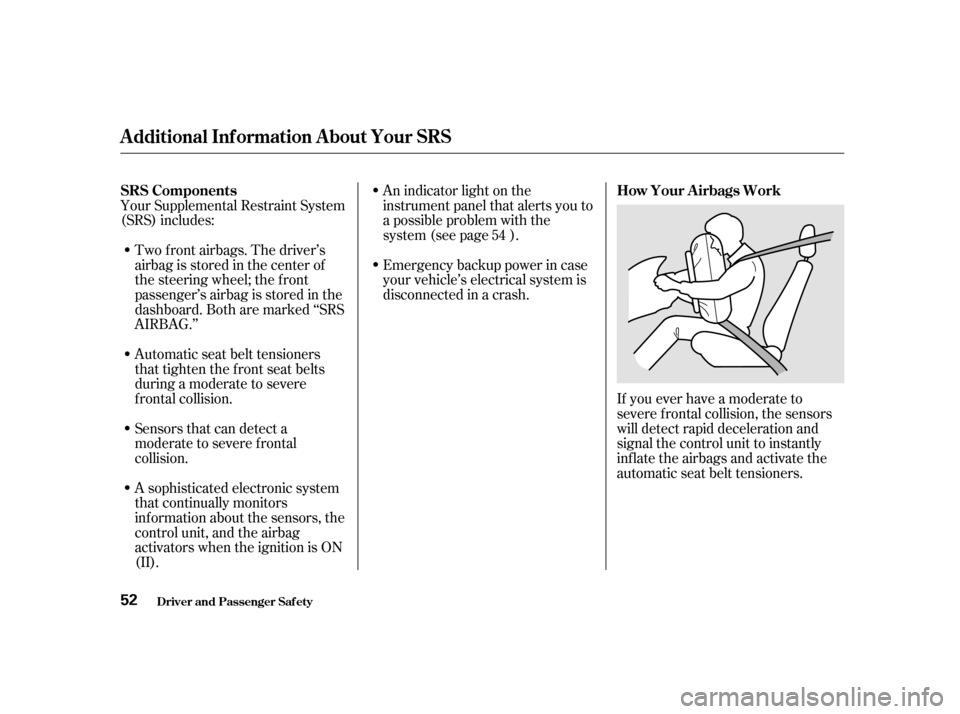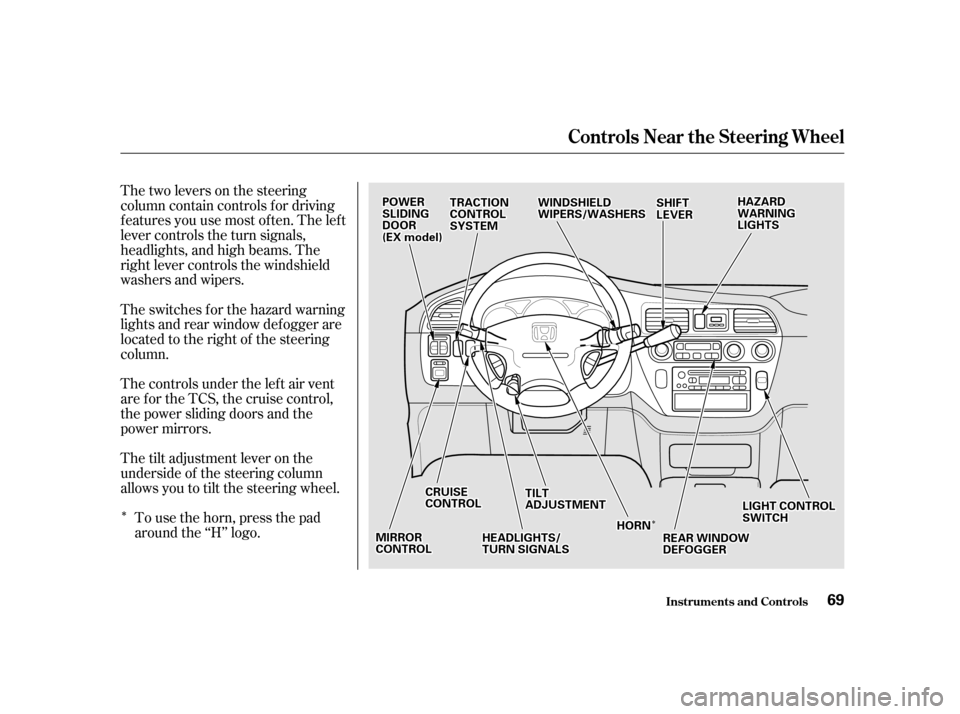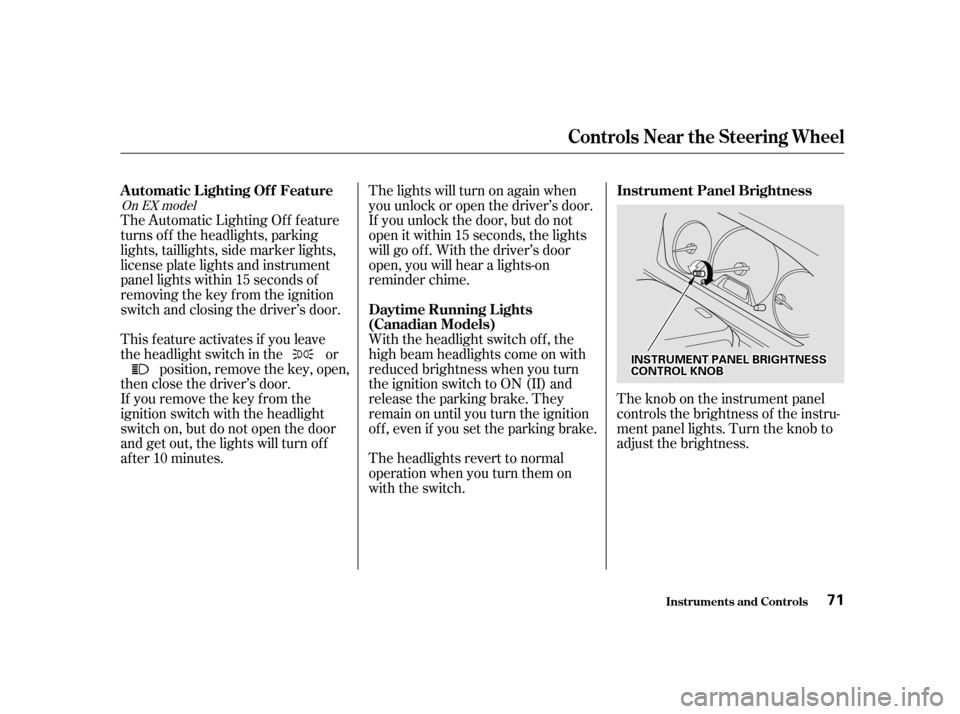Page 20 of 363

If your
hands or arms are close to the
airbag covers in the center of the
steering wheel and on top of the
dashboard, they could be injured if
the airbags inf late.
Carrying hard or sharp objects on
your lap, or driving with a pipe or
other sharp object in your mouth,
can result in injuries if your
airbags inflate. Devices intended to improve
occupant comf ort or reposition the
shoulder part of a seat belt can
severely compromise the
protective capability of the seat
belt and increase the chance of
serious injury in a crash.
Any object
attached to or placed on the covers
marked ‘‘SRS AIRBAG,’’ in the
center of the steering wheel and
on top of the dashboard, could
interf ere with the proper operation
of the airbags. Or, if the airbags
inf late, the objects could be
propelled inside the car and hurt
someone.
Protecting Adults
Driver and Passenger Saf ety
K eep your hands and arms away
f rom t he airbag covers.
Do not place hard or sharp object s bet ween yourself and an airbag.
Do not put any accessories on seat
belts.
Do not at t ach or place object s onthe airbag covers.
21
Page 51 of 363

Your Supplemental Restraint System
(SRS) includes:Two f ront airbags. The driver’s
airbag is stored in the center of
the steering wheel; the f ront
passenger’sairbagisstoredinthe
dashboard. Both are marked ‘‘SRS
AIRBAG.’’
If you ever have a moderate to
severe f rontal collision, the sensors
will detect rapid deceleration and
signal the control unit to instantly
inflate the airbags and activate the
automatic seat belt tensioners.
Automatic seat belt tensioners
that tighten the front seat belts
during a moderate to severe
f rontal collision.
Sensors that can detect a
moderate to severe frontal
collision.
A sophisticated electronic system
that continually monitors
inf ormation about the sensors, the
control unit, and the airbag
activators when the ignition is ON
(II). An indicator light on the
instrument panel that alerts you to
a possible problem with the
system (see page ).
Emergency backup power in case
your vehicle’s electrical system is
disconnected in a crash.
54
SRS Components
How Your A irbags Work
Additional Inf ormation About Your SRS
Driver and Passenger Saf ety
52
Page 58 of 363

This section gives inf ormation about
the controls and displays that
contribute to the daily operation of
your Honda. All the essential
controls are within easy reach............................
Control Locations . 60
...............................
Indicator Lights . 61
.............................................
Gauges . 66
Controls Near the Steering
.......................................
Wheel . 69
...................................
Headlights . 70
Automatic Lighting Off
.....................................
Feature . 71
............
Daytime Running Lights . 71
....
Instrument Panel Brightness . 71
................................
Turn Signals . 72
.....................
Windshield Wipers . 72
..................
Windshield Washers . 74 Rear Window Wiper and
.....................................
Washer . 74
..........................
Hazard Warning . 75
.............
Rear Window Def ogger . 75
......
Steering Wheel Adjustment . 76
...............
Steering Wheel Controls . 77
.............................
Cruise Control . 77
.............
Remote Audio Controls . 80
...............................
Keys and Locks . 80
..............................................
Keys . 80
....................
Immobilizer System . 81
............................
Ignition Switch . 82
......................
Power Door Locks . 83
...................
Remote Transmitter . 85
..............
Childproof Door Locks . 89
........................................
Tailgate . 89
....................................
Glove Box . 91
.....................
Manual Sliding Doors . 92
.......................
Power Sliding Doors . 93
HomeLink Universal
.................................
Transmitter . 99
...............................................
Seats . 104
....................
Passenger Seating . 104
......................
Seat Adjustments . 105
Driver’s Seat Manual Height
............................
Adjustment . 107 Driver’s Seat Power
..........................
Adjustments . 108
....................................
Armrests . 109
........................
Head Restraints . 110
.....................
Third Seat Access . 111
Moving the Second Row
...........................
Bucket Seat . 112
Removing the Bucket Seats ................
in the Second Row . 114
.............
Folding the Third Seat . 115
............................
Power Windows . 118
...........................................
Mirrors . 121
...............................
Parking Brake . 122
..................................
Digital Clock . 123
..................................
Center Table . 123
...........................
Beverage Holder . 124
........................
Sunglasses Holder . 126
........................................
Sun Visor . 127
................................
Vanity Mirror . 127
.......................
Rear Compartment . 128
...............................
Center Pocket . 128
...................................
Coin Holder . 128
...................................
Storage Box . 129
......................................
Coat Hook . 129
............
Accessory Power Sockets . 130
...............................
Interior Lights . 131
Instruments and Controls
Inst rument s and Cont rols 59
Page 68 of 363

�Î�Î
�Î
Thetwoleversonthesteering
column contain controls f or driving
f eatures you use most of ten. The lef t
lever controls the turn signals,
headlights, and high beams. The
right lever controls the windshield
washers and wipers.
The switches for the hazard warning
lights and rear window def ogger are
located to the right of the steering
column.
The controls under the lef t air vent
arefortheTCS,thecruisecontrol,
the power sliding doors and the
power mirrors.
The tilt adjustment lever on the
underside of the steering column
allows you to tilt the steering wheel.
To use the horn, press the pad
around the ‘‘H’’ logo.
Inst rument s and Cont rols
Controls Near the Steering Wheel
69
CCRRUUIISSEECCOONNTTRROOLL
HHEEAADDLLIIGGHHTTSS//TTUURRNNSSIIGGNNAALLSS
TTIILLTTAADDJJUUSSTTMMEENNTT
RREEAARRWWIINNDDOOWWDDEEFFOOGGGGEERR
SSHHIIFFTTLLEEVVEERRWWIINNDDSSHHIIEELLDDWWIIPPEERRSS//WWAASSHHEERRSS
MMIIRRRROORRCCOONNTTRROOLL
HHOORRNN
LLIIGGHHTTCCOONNTTRROOLLSSWWIITTCCHH
HHAAZZAARRDDWWAARRNNIINNGGLLIIGGHHTTSS
PPOOWWEERRSSLLIIDDIINNGGDDOOOORR((EEXXmmooddeell))
TTRRAACCTTIIOONNCCOONNTTRROOLLSSYYSSTTEEMM
Page 69 of 363
If you leave the lights on with the
ignition switch in ACCESSORY (I)
or LOCK (0), you will hear a
reminder chime when you open the
driver’s door.
To change between low beams and
high beams, pull the turn signal lever
until you hear a click, then let go.
The blue high beam indicator will
light (see page ).To f lash the high beams, pull the
turn signal lever back lightly, then
release it. The high beams will come
on and go off.
The high beams will stay on f or as
long as you hold the lever back, no
matter what position the headlight
switch is in.
The rotating switch on the lef t lever
controls the lights. Turning this
switch to the ‘‘ ’’ position turns
on the parking lights, taillights,
instrument panel lights, side-marker
lights, and rear license plate lights.
Turning the switch to the ‘‘ ’’
position turns on the headlights. 65
Controls Near the Steering Wheel
Inst rument s and Cont rols
Headlights 70
Page 70 of 363

The Automatic Lighting Of f f eature
turns of f the headlights, parking
lights, taillights, side marker lights,
license plate lights and instrument
panel lights within 15 seconds of
removing the key from the ignition
switch and closing the driver’s door.The lights will turn on again when
you unlock or open the driver’s door.
If you unlock the door, but do not
open it within 15 seconds, the lights
will go off. With the driver’s door
open, you will hear a lights-on
reminder chime.
With the headlight switch off, the
high beam headlights come on with
reduced brightness when you turn
the ignition switch to ON (II) and
release the parking brake. They
remain on until you turn the ignition
of f , even if you set the parking brake.
The headlights revert to normal
operation when you turn them on
with the switch.
Theknobontheinstrumentpanel
controls the brightness of the instru-
ment panel lights. Turn the knob to
adjust the brightness.
This feature activates if you leave
the headlight switch in the or
position, remove the key, open,
then close the driver’s door.
If you remove the key f rom the
ignition switch with the headlight
switch on, but do not open the door
and get out, the lights will turn of f
af ter 10 minutes.
On EX model
Controls Near the Steering Wheel
Inst rument s and Cont rols
Automatic Lighting Of f Feature
Daytime Running L ights
(Canadian Models)Instrument Panel Brightness
71
IINNSSTTRRUUMMEENNTTPPAANNEELLBBRRIIGGHHTTNNEESSSSCCOONNTTRROOLLKKNNOOBB
Page 71 of 363
Signal a turn or lane change with this
lever. Push down on the lever to
signal a lef t turn, and up to signal a
right turn. If you push it up or down
all the way, the turn signal continues
to blink even when you release the
lever. It shuts off automatically as
you complete the turn.To signal a lane change, push lightly
on the turn signal lever in the proper
direction and hold it. The lever will
return to the center position as soon
as you release it.
The right lever controls the wind-
shield wipers and washers. The
rotary switch at the end of the lever
has three positions:INT: intermittent : low speed
: high speed
T urn Signals
Windshield Wipers
Inst rument s and Cont rols
Controls Near the Steering Wheel
72
TTUURRNNSSIIGGNNAALLLLEEVVEERR
Page 72 of 363
To operate the wipers in mist mode,
push the control lever down. The
wipers run at high speed until you
release the lever. This gives you a
quick way to clear the windshield.
In intermittent, the wipers operate
every f ew seconds. You can vary
how of ten the wipers sweep the
windshield by turning the INT TIME
ring next to the rotary switch. The
sweep interval will change slightly
with speed; getting shorter as you
drive f aster. In low speed and high
speed, the wipers run continuously. If you turn the INT TIME ring to the
shortest delay, the wipers will
change from intermittent to low
speed operation when vehicle speed
exceeds 12 mph (20 km/h).
Controls Near the Steering Wheel
Inst rument s and Cont rols
73